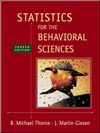 |  Statistics for the Behavioral Sciences, 4/e Michael Thorne,
Mississippi State University -- Mississippi State
Martin Giesen,
Mississippi State University -- Mississippi State
The Language of Statistics
Chapter OverviewStatistics are summary numbers, or indices, that result from the analysis of data. Statistics is also a set of tools concerned with the collection, organization, and analysis of numerical facts or observations. There are at least three good reasons for taking a course in statistics:- We are surrounded by statistics, and some statistical sophistication will make us more informed consumers of statistics.
- A knowledge of statistics is necessary for an understanding of the specialized literature in the behavioral sciences.
- Behavioral scientists need statistical techniques to deal with the variability that is inherent in observations made on living organisms. Statistics is the branch of mathematics that deals with variability.
Although it uses numbers, statistics isn't completely mathematical. In fact, it can be viewed as a language, with new vocabulary to learn as well as "grammar" and "syntax," which are used to draw inferences and make decisions about hypotheses. As with a second language, the best way to learn statistics is by doing it, by practice and more practice.
Although statistics isn't strictly a mathematics course, some mathematical skill is necessary. If it has been a while since you had your last mathematics course, take time to read and work through Appendix 1 in your text or in this Study Guide. Among the tools you will need for the course, we recommend a good, but inexpensive, light-powered calculator; take the time to work through the instructions you receive with your calculator. In addition, be prepared to do homework and attend class regularly.
Finally, we recognize that many of you probably entered this course with a certain degree of anxiety. Although this anxiety is quite natural, it is to a large extent unwarranted. By regularly attending class, reading the text, and working problems outside the classroom, you will succeed in this course. |
|



 2003 McGraw-Hill Higher Education
2003 McGraw-Hill Higher Education